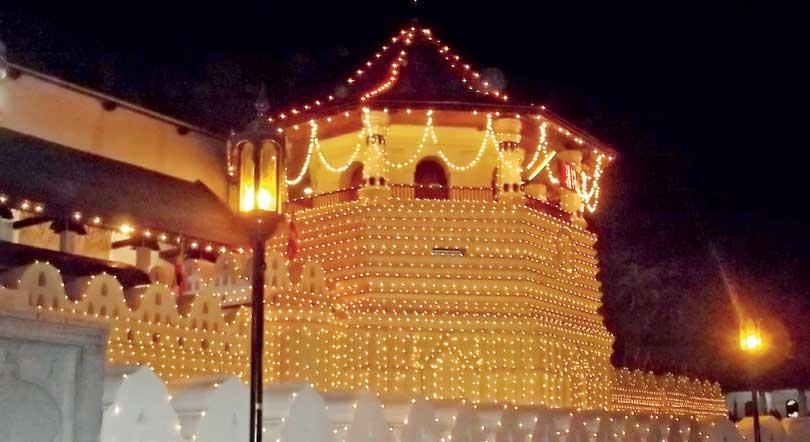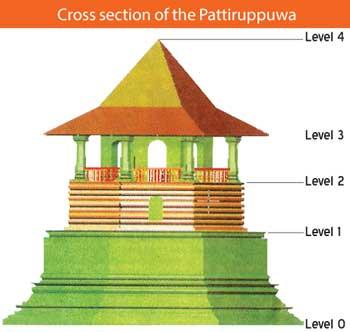26 Mar 2019 - {{hitsCtrl.values.hits}}

Pattiruppuwa at night
 When the Sri Dalada Maligawa was bombed in 1998, 20 years ago on January 25, precisely at 5.35 am, the service monks were on the verge of opening the Shrine room doors. The Pattirippuwa (Octagon) of the Dalada Maligawa in Kandy was built by the architect Devendra Moolacarya, during the reign of King Sri Wickrama Rajasingha, (1798-1815 AD). If not for this architect, Sri Lanka would have lost an architectural masterpiece.
When the Sri Dalada Maligawa was bombed in 1998, 20 years ago on January 25, precisely at 5.35 am, the service monks were on the verge of opening the Shrine room doors. The Pattirippuwa (Octagon) of the Dalada Maligawa in Kandy was built by the architect Devendra Moolacarya, during the reign of King Sri Wickrama Rajasingha, (1798-1815 AD). If not for this architect, Sri Lanka would have lost an architectural masterpiece.
Sri Wickrama Rajasinghe is known as a cruel King owing to his order to make Ehelepola Kumarihamy pound her children at Deva-Sanhinda, viewing the pounding from his Palace. But, he was man who had an aesthetic sense. He built the Kandy Lake and above all the Pattirippuwa or the Octagon. The toil and sweat of the Kandyan people lie in the Kandy Lake where men died during the building and digging for the Lake. Though we class him cruel, this King presented royal land to the families who lost their breadwinner in Deiyannewela and Suduhumpola.
Following the bomb blast, the Pattirippuwa was in ruins and many advocated that this structure should be demolished and rebuilt. Diyawadana Nilame of that time, Niranjan Wijeyaratne would have nothing of this suggestion and went on to scout for a person who could advise him. It was then, that Emeritus Prof. Munidasa P. Ranaweera of the Faculty of Engineering of the University of Peradeniya came on to the rescue. It was his belief that the Pattiripuwa could be rehabilitated saving the ancient structure for posterity.
By this time the roof of the Pattirippuwa had been attacked by dry rot. Dry rot is wood decay caused by certain species of fungi that digest parts of the wood, which give the wood strength and stiffness. The bomb was a blessing in disguise. Diyawadana Nilame Wijeyaratne knew that due to the intervention of the Venice Charter signed by Sri Lanka which stipulates minimum intervention of any historic structure in the country, the Pattirippuwa cannot be brought down. The most important implications of the Venice Charter are Articles two and three;
· Article 2 reads “The conservation of monuments must have recourse to all the sciences and techniques which can contribute to the study and safeguarding of the architectural Heritage.”
· Article 3 reads “The intention in conserving and restoring monuments is to safeguard them no less as works of art than a historical evidence.”
As a result, the question of how to recreate the once bomb-ripped Octagon without causing any harm to its character was the challenge authorities were presented with.
In this situation, Dalada Maligawa authorities sought the help of the University of Peradeniya. The guidance of Prof. MunidasaP. Ranweera of the Department of Civil Engineering of the Faculty played a key role in overcoming this challenge. According to Prof. Ranweera, the octagon is ‘Gem of Kandyan Architecture.’
After the blast the Sri Dalada Maligawa complex sustained heavy damages and an extensive programme to repair the complex was initiated. Restoration of the Maligawa back to its original state was envisaged and was given high priority and special committees were appointed to formulate an action plan. Diyawadana Nilame initiated the “Sri Dalada Maligawa Restoration Fund” maintaining that the government of the day did not allocate any funds for the restoration.
The main rehabilitation work was undertaken by the State Engineering Corporation with the armed services together with the Sri Lanka Ports Authority (SLPA). The reconstruction of the Maligawa complex was undertaken by the State Engineering Corporation and Prof. Ranaweera was tasked with assessing the damage to the structure and formulating remedial measures.
 Prof. Ranaweera realized that the Octagon was located next to the moat on the west where it rises from level ‘O’ as shown in the diagram and on the East side the foundation is at level I, extending to a height of 260 ‘ from the level ‘O’ to level I’. The building was ringed by two 26 inch thick inner and outer walls forming two Octagons, sometimes with openings for doors.The outer walls at the west side have a window and there are seven radial walls connecting to the outer and inner walls at the vertices of the inner and outer region.
Prof. Ranaweera realized that the Octagon was located next to the moat on the west where it rises from level ‘O’ as shown in the diagram and on the East side the foundation is at level I, extending to a height of 260 ‘ from the level ‘O’ to level I’. The building was ringed by two 26 inch thick inner and outer walls forming two Octagons, sometimes with openings for doors.The outer walls at the west side have a window and there are seven radial walls connecting to the outer and inner walls at the vertices of the inner and outer region.
The Historic Oriental Archive (later turned into an archival-library and once the office of Sir John D’Oyly, which was little used at level ‘2’ . It has an inner Octagon composed of 26” thick walls with door openings and at vertices of the outer Octagon of side 182’ with eight masonry columns of mean diameter at 29”
Earlier one Prof. F. Walley had propagated the theory that earth shock damage from bombs exploded at ground level is confined to the order of two or three times the crater radius. “Prof. Walley’s theory has been aptly proven in the Sri Dalada Maligawa Bomb Blast” said Prof. Ranaweera.
The opinion of Prof. Ranaweera was that the damage to the Maligawa was due to pressure and suction at the centre of the explosion. But, there had been no visible damage to the foundation of the building according to him. The moat around the octagon seems to have played a protective role by cutting off transmission of ground waves of the explosive.
It was at this stage it was advocated to break down the walls of the octagon.
Prof. of Engineering of the University of Cambridge J. Heymen, who had made a study of Ely Cathedral in the UK and who had also made studies of many ancient masonry structures has laid down the principles governing their restoration. According to Prof. Ranaweera, Prof. Heyman has found that in many ancient masonry structures, there is an element of fortification perhaps as a precaution against breakdown. He has also introduced the concept of ‘ Background stress’ pressure of around 1/1000, if the crushing strength (which is all that is necessary) to avoid the danger of sliding and general loss of cohesion of the masonry. The total repair cost was estimated around Rs. Three million. “It was also interesting to discover a typical Kandyan style roof with what is called hip rafters, supported by finished beams” said Prof. Ranaweera.
The observed damage was confined to the Octagon’s upper parts, as in the case of most other sections of the Sri Dalada Malligawa Complex. The main shrine of the Maligawa was built by King Wimaladharmasuriya and rebuilt by later Kings thereafter. The severe onslaught withstood the blast, perhaps it has been later found to be due to the wattle and dub building. But, no one has until now taken the interest to go into the details of the blast on the Maligawa.
The Pattirippuwa obviously needed a major roof and only ‘cosmetic ‘ repairs for the structure below level 2, said Prof. Ranaweera. The analysis of this assessment was done on the Computer Aided Design (CAD) Laboratory of the Department of civil engineering of the Faculty. He also added that in order to determine the behaviour of the structure, a three dimension finite element model of the whole structure was made using “shell and frame elements.” Also immediately after the blast the cracked structures had become stable and no further cracking or displacement have been noticed.
Even the foundations did not show any disturbance due to the blast and one may rule out of any further ‘settlements’ had they been noticed. So it was the opinion of Prof. Ranaweera that the need was to consolidate the loose building and rubble infill into the cracks.
Guided by the principles of conservation and using the theories, governing the restoration of the masonry structures, it was possible to restore this Gem of Kandyan Architecture to its pristine lustre.
Former Diyawadana Nilame Niranjan Wijeyaratne said that although the government of that time did not fund restoration, no sooner Prime Minister Ranil Wickramasinghe arrived at the Maligawa, he requested that compensation be given to the damages incurred. At the first Cabinet meeting he granted Rs.140 million to be allocated for the rehabilitation process, which was in fact paid to the State Engineering Corporation.
He also added that Minister Lakshman Jayakody collected monies but could not spend the public money, which had to go through the Trustee of the Maligawa and therefore that money was given to the Maligawa Trust Fund.
29 Nov 2024 29 Nov 2024
29 Nov 2024 29 Nov 2024
29 Nov 2024 29 Nov 2024
29 Nov 2024 29 Nov 2024
29 Nov 2024 29 Nov 2024